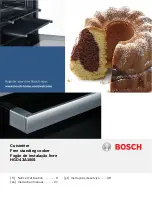
en
Causes of damage
6
:
Warning – Risk of electric shock!
When replacing the cooking compartment
bulb, the bulb socket contacts are live. Before
replacing the bulb, unplug the appliance from
the mains or switch off the circuit breaker in
the fuse box.
]
Causes of damage
Causes of damage
Hob
Caution!
■
Rough pot and pan bases scratch the ceramic.
■
Avoid boiling pots dry. This may cause damage.
■
Never place hot pots or pans on the control panel,
the display area or the surround. This may cause
damage.
■
Damage can occur if hard or pointed objects fall on
the hob.
■
Aluminium foil and plastic containers melt on hot
hotplates. Oven protective foil is not suitable for your
hob.
Overview
The following table provides an overview of the most
frequent kinds of damage:
Damage to the oven
Caution!
■
Accessories, foil, greaseproof paper or ovenware on
the cooking compartment floor: do not place
accessories on the cooking compartment floor. Do
not cover the cooking compartment floor with any
sort of foil or greaseproof paper. Do not place
ovenware on the cooking compartment floor if a
temperature of over 50 ºC has been set. This will
cause heat to accumulate. The baking and roasting
times will no longer be correct and the enamel will
be damaged.
■
Aluminium foil: Aluminium foil in the cooking
compartment must not come into contact with the
door glass. This could cause permanent
discolouration of the door glass.
■
Water in a hot cooking compartment: do not pour
water into the cooking compartment when it is hot.
This will cause steam. The temperature change can
cause damage to the enamel.
■
Moisture in the cooking compartment: Over an
extended period of time, moisture in the cooking
compartment may lead to corrosion. Allow the
cooking compartment to dry after use. Do not keep
moist food in the closed cooking compartment for
extended periods of time. Do not store food in the
cooking compartment.
■
Cooling with the appliance door open: Following
operation at high temperatures, only allow the
cooking compartment to cool down with the door
closed. Do not trap anything in the appliance door.
Even if the door is only left open a crack, the front of
nearby furniture may become damaged over time.
Only leave the cooking compartment to dry with the
door open if a lot of moisture was produced whilst
the oven was operating.
■
Fruit juice: when baking particularly juicy fruit pies,
do not pack the baking tray too generously. Fruit
juice dripping from the baking tray leaves stains that
cannot be removed. If possible, use the deeper
universal pan.
■
Extremely dirty seal: If the seal is very dirty, the
appliance door will no longer close properly during
operation. The fronts of adjacent units could be
damaged. Always keep the seal clean. Never
operate the appliance if the seal is damaged or
missing.
■
Appliance door as a seat, shelf or worktop: Do not
sit on the appliance door, or place or hang anything
on it. Do not place any cookware or accessories on
the appliance door.
■
Inserting accessories: depending on the appliance
model, accessories can scratch the door panel
when closing the appliance door. Always insert the
accessories into the cooking compartment as far as
they will go.
Damage
Cause
Action
Stains
Food spills
Remove spills immediately with a glass scraper.
Unsuitable cleaning agents
Only use cleaning agents which are suitable for ceramic
Scratches
Salt, sugar and sand
Do not use the hob as a work surface or storage space.
Rough pot and pan bases scratch the
ceramic.
Check your cookware.
Discolouration
Unsuitable cleaning agents
Only use cleaning agents which are suitable for ceramic
Pan abrasion (e.g. aluminium)
Lift the pots and pans when moving them.
Blisters
Sugar, food with a high sugar content
Remove spills immediately with a glass scraper.
Содержание HKL050070M
Страница 2: ......







































